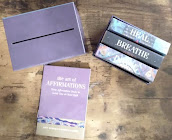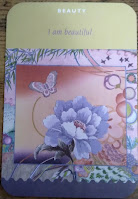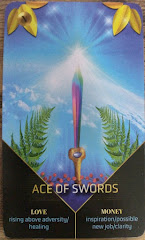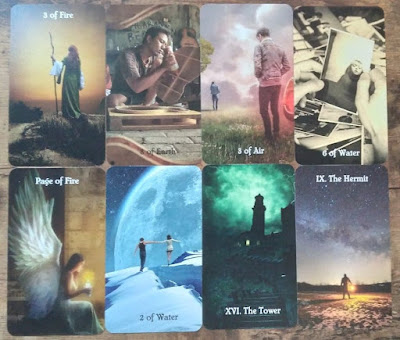Author: Debra Zachau
Artist: Kait Matthews
Red Feather/Schiffer Publishing, 2022
Description: 78 card deck, 176-page guidebook, lift-lid box
Card Size: 3 by 5
"Now the secrets of the Tarot are brought to light so that anyone can clearly hear the powerful messages that will resonate with one's soul through the Clarity Tarot."
A Tarot deck is a personal tool to help guide you in your journey. Your choice of deck is also very personal. While I did not feel a connection with this deck or its design, you may fall in love with it. I hope this review will help you in your decision.
My main concern with this deck is the quality of the card stock. Although the thin stock allows for easy shuffling, it also allows for easy wear. The cards without use are already peeling and curling on the edges. I'm not sure how much damage will occur over time, or even if more damage will occur at all. I've never used a deck of this quality.
The guidebook begins with a short introduction and then shares the five unique components of the Clarity Tarot.
You not only know what spirit is trying to tell you but 'how to say it' in a way that is completely unbiased, centered, and supportive of someone who may be needing direction.
1. Keywords on Love and Money - the author suggests that the keywords will make it easier to know you are going by intuition over imagination.
The most-asked questions are about love, while the second most popular are money and career. Although this statement may be true overall in the Tarot world, these are not my main focus, so I find the keywords distracting.
2. Easy Yes/No Answers - No one is satisfied with just a yes or no answer, so this deck answers not only yes or no but why the answer is yes and why the answer is no! Someone may find this component helpful, but I, personally, avoid such yes or no question altogether.
3. Timing Is Everything - This may have been a nice feature, but there must have been some confusion between author and artist. The focus is on the Major Arcana cards for this timing technique. That major card will have a number on it: a Roman number on the left and a modern number on the right. That number will be from 0-21. You will then use your intuition to decide if the time increments are days, weeks, or months.
As you can see on the Magician, there are no numbers on the card at all. With the mention of 0-21, I assume you are using the original number of the Major Arcana cards. But the fact that the author and artist didn't follow each other on this idea is a problem for me. Also, the technique of laying cards down until you find a Major Arcana Card for a timing question seems unreliable in my opinion.
4. Rich Cultural Images - Tarot is a very old form of divination, and traditional decks hold traditional Old-World biases, especially within the court cards. The idea that this deck is unique because it offers other cultures would have been true at some point in time, but most decks I see now are very diverse in their representation of people throughout the cards.
5. The Design - Kait Matthews has brought together an exquisite combination of colors, symbols and images in a collage that inspires and delights not only you the advisor but your clients as well. The images of the deck are unique and interesting, some more than others. Overall, I do like the images the artist created for the deck. Without the distractions, I believe this would be a nice working Tarot deck.
The author then shares a short section on how to use this deck, which briefly covers the Major and Minor Arcana, ways to cast a throw or spread, and reversals.
Part Two of the guidebook, What's in a Number, is definitely worth the read. This section covers the Minor Arcana, beginning with meanings of the numbers 1-10 and then covers the suits before diving into the individual cards.
The Minor Arcana card section is brief with no images. The short sections cover card title, Y or N, a short paragraph on meaning and gives the keywords that appear on the card.
The Court Cards are then covered with a short introduction into the royal court, and then presents each suit as a separate family in an imaginary neighborhood. Each family is presented as a whole and then as individuals. The individual text includes title, Y or N, a description of the individual and the keywords that appear on the card.
Part Three covers the Major Arcana with a brief overview and then the individual cards, including title, Y or N, meaning, and gives the keywords that appear on the card.
In my opinion, the card meanings are worth looking over in the guidebook, but it would have been nice to hear more about the actual images. The author mentioned the uniqueness of the decks' design, but never mentions in the card section anything about the exquisite combination of colors, symbols and images. If this is one of the components making the deck unique, shouldn't there be some mention of the description of the cards - the colors and symbols chosen to make them unique?
The last part of the guidebook is titled How to Give Awesome Readings. This section covers framing questions, using your intuition and three spreads (The Celtic Cross, Five-Card Yes/No, and a Timing Spread).
A cheat sheet is provided containing card title and keywords. Since these keywords are on the cards themselves, I'm not sure why you would need a cheat sheet.
The guidebook closes with Serving the World, where the author shares her experience of different jobs as a Tarot specialist. In the final words of the author, she mentions videos online to help you learn the tarot, but doesn't give any information about where you might find these.
Overall, I found the card images decent, and they closely follow the Rider-Waite theme. The guidebook was lacking in my opinion, although some sections are worth the read. I was extremely disappointed by the card stock quality, which isn't something you normally need to worry about with a Schiffer produced deck.
However, if you can look past the card stock and the distracting keywords, you may wish to give this deck a try. A new reader may find the keywords useful. Since the deck follows the traditional themes in the card images, it may be a good starter deck. As a seasoned reader, I find the decks' components distracting and unnecessary.
I am considering trimming off the keywords and adding the deck to my shelf. I'm just not sure if it's worth the time and effort to do so.
Kait Matthews is offering complimentary decks on her
website for reviews, if you'd like to go that route and give the deck a chance.
(Review Product supplied by Schiffer Publishing)

















































